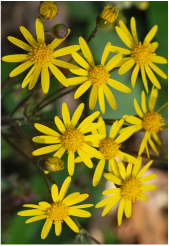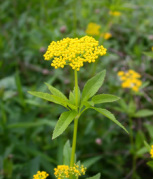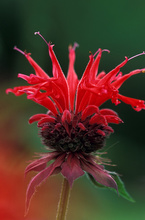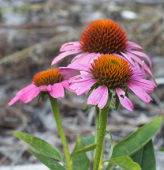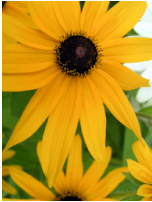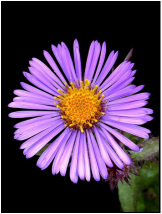six picks for a season of blooms!
A well planned pollinator garden should always be blooming, offering a buffet of blossoms from spring through fall. These six selections, two early, two mid, and two late season blooming plants, represent some of the best choices for bloom time and duration. Start with these six, fill in with some long blooming annuals, and a carefully selected shrub or tree, and you're on your way to a perfect pollinator patch!
Early SEASON
Golden ragwort Packera aureaBloom Period: Late April - Early June
Why we love it: There's SO much to love about golden ragwort! Thick, rounded, semi-evergreen foliage forms a dense, spreading basal mound that gives rise to stems of profuse yellow daisy-like flowers from late April through June. Vigorous and tough, it provides cover for many woodland critters, forms a superb groundcover and thrives in shady, moist areas. One of the earliest and longest blooming native flowers, it is an important nectar and pollen source for native bees. |
Golden Alexander zizia aurea, zizia apteraBloom Period: Mid-May - Early June
Why we love it: This early blooming member of the carrot family produces flat-topped clusters of tiny yellow flowers. Zizia aurea has slender toothed compound leaves, where as Zizia aptera has simple heart-shaped leaves. As with all members of the carrot family, golden alexander is a host plant for eastern black swallowtail and Missouri woodland swallowtail. |
MID SEASON
BEE BALM Monarda spp.Bloom Period: June - Jul
Why we love it: The bright crown of tubular flowers make plants of the Monarda genus instantly recognizable. Members of the mint family, they often have aromatic foliage. In fact, wild bergamot (Monarda fistulosa) provides the trademark scent for Earl Grey Tea. Red bee balm (Monarda didyma) is sometimes called Oswego tea as it was used by the Native American tribe for that purpose. We love it however because bees love it! Also hummingbirds and other pollinators as well. |
PURPLE CONEFLOWER Echinacea purpureaBloom Period: June - Aug
Why we love it: Maybe because of its bright pink petals, graceful drooping habit, or its ability to attract a wide range of butterflies and other pollinators - purple coneflower has become a ubiquitous sight in the mid-summer garden well beyond its native mid-western range. Whatever the reason, purple coneflower is an easy choice for filling the mid-season garden with color and sources of nectar for pollinators. |
Late Season
Brown/black-eyed susans Rudbeckia spp.Bloom Period: June - Oct
Why we love it: Another easy to find native plant, 'Susans' are a winner for providing a long period of cheery yellow blooms. Often coming into bloom around the same time as purple coneflower, the two make an attractive pairing. While there are many hybrids, the annual Rudbeckia hirta and perennial Rudbeckia triloba are two native species to consider. R. hirta is compact, growing to less than 2 ft', whereas R. triloba will grow to 5ft with masses of smaller flowers. Both are considered an annual, or short-lived perennial that generally re-seeds itself year after year. |
AstersBloom Period: June - Oct
Why we love it: While asters have undergone a botanical identity crisis in recent years, changing their name to the difficult to pronounce Symphyotrichum, we still love them anyway. There are MANY species of aster to choose from to meet the needs and preferences of any garden. Whether you appreciate the dense mounds of aromatic aster, the wispy calico aster with its many tiny flowers, or the vibrant hues of New England or smooth blue aster, all are important long-blooming late seasons nectar sources. They support monarchs during migration, as well as native bees preparing to hibernate. Plus, they are that last hurrah of color that complements fall foliage. |

